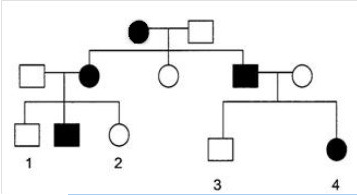Below is a pedigree of a human genetic disease in which solid color indicates affected individuals. Assume that the disease is caused by a gene that can have the alleles A or a. If individuals 1 and 4 have a child together, what is the probability that the child will exhibit the disease?

A) 0%
B) 25%
C) 50%
D) 75%
E) 100%
C) 50%
You might also like to view...
Using the natural processes of cell growth and development to replace diseased or damaged tissue is called:
A. cloning. B. stem cell transplantation. C. genetic engineering. D. regenerative medicine. E. stem cell therapy.
The important feature of all cells that react to a
specific hormone is (are) the
a. type of blood supply they receive. b. proximity of the endocrine gland. c. presence of an appropriate receptor molecule. d. characteristics of their plasma membranes. e. presence of specific genes responsive to the hormone.
What is the relationship between the narrow-sense heritability (h2 ) index and the impact of selection?
What will be an ideal response?
All female mammals have one active X chromosome per cell instead of two. What causes this?
A) activation of the XIST gene on the X chromosome that will become the Barr body B) activation of the BARR gene on one X chromosome, which then becomes inactive C) inactivation of the XIST gene on the X chromosome derived from the male parent D) attachment of methyl (CH3 ) groups to the X chromosome that will remain active